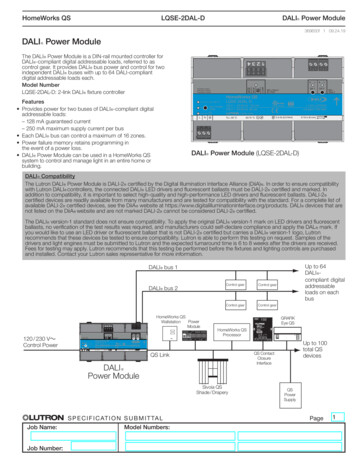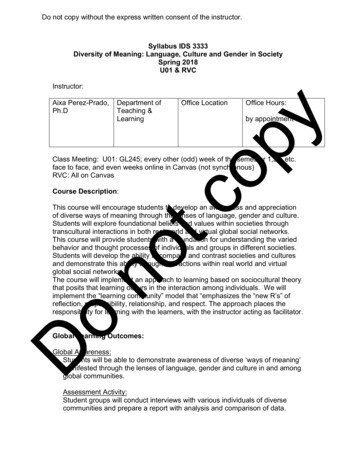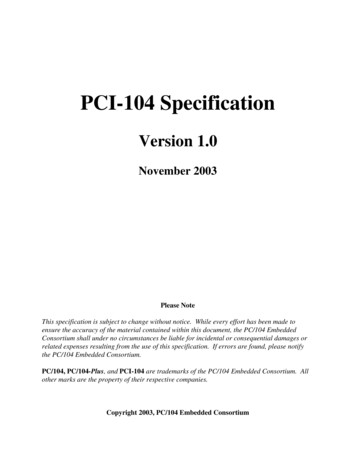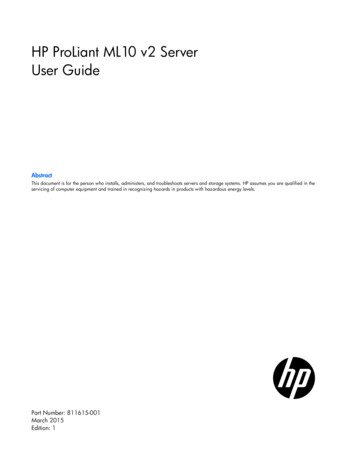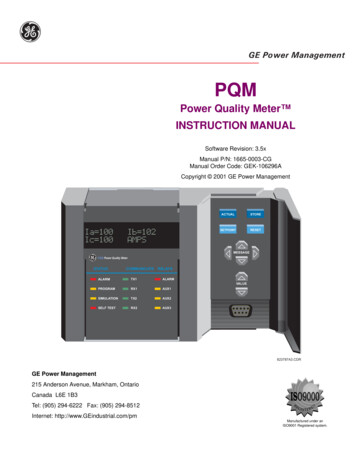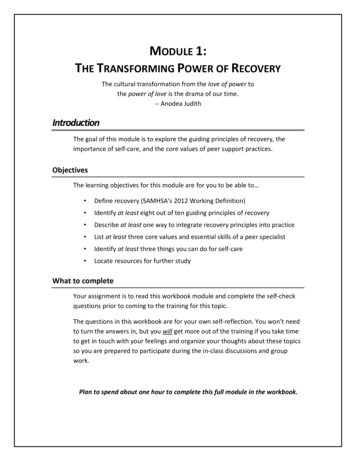
Transcription
MODULE 1:THE TRANSFORMING POWER OF RECOVERYThe cultural transformation from the love of power tothe power of love is the drama of our time.-- Anodea JudithIntroductionThe goal of this module is to explore the guiding principles of recovery, theimportance of self-care, and the core values of peer support practices.ObjectivesThe learning objectives for this module are for you to be able to Define recovery (SAMHSA’s 2012 Working Definition) Identify at least eight out of ten guiding principles of recovery Describe at least one way to integrate recovery principles into practice List at least three core values and essential skills of a peer specialist Identify at least three things you can do for self-care Locate resources for further studyWhat to completeYour assignment is to read this workbook module and complete the self-checkquestions prior to coming to the training for this topic.The questions in this workbook are for your own self-reflection. You won’t needto turn the answers in, but you will get more out of the training if you take timeto get in touch with your feelings and organize your thoughts about these topicsso you are prepared to participate during the in-class discussions and groupwork.Plan to spend about one hour to complete this full module in the workbook.
CONTENTSIntroduction .1Objectives. 1What to complete . 1Assignment #1: Your personal definition of recovery . 3A Brief History of Recovery (in Mental Health).4Today’s ‘Working’ Definition of Recovery .4Recovery from substance use (addiction) conditions. 5Dimensions of recovery . 5Assignment #2: SAMHSA’s definition of recovery . 5Guiding principles of recovery .6Assignment #3: Putting recovery principles into practice . 9Recovery is Value-Based . 10Assumptions about recovery . 10Assignment #4: Assumptions about recovery and peer support . 12Peer Support is Value-Based . 13Self-Care . 14What are the benefits of self-care? . 14Assignment #5: Fun things to do . 18Self-Care Planning . 22For Further Study: Resilience . 23For Further Study: Communication Skills . 24eCPR . 24Non-Violent or Compassionate Communication (NVC). 25Alternatives to Violence Project (AVP) . 25For Further Study: Transforming Power . 26Summary Checklist. 28Selected References Resources For Further Study . 31Appendix 1-A: Fun Things To Do . 38Recovery to Practice Participant Workbook–v1 April 2014Module 1: The Transforming Power of RecoveryPage 1-2
Assignment #1: Your personal definition of recovery (1)To me, recovery is:(2)My definition of recovery is the same as it was five years ago. Yes / No.If no, what has changed?(3)I think most people define recovery in the same way as I do. Yes / No.If no, what is different about the way you define recovery?Questions / Notes to bring to the training:Recovery to Practice Participant Workbook–v1 April 2014Module 1: The Transforming Power of RecoveryPage 1-3
A Brief History of Recovery (in Mental Health)For years, mental health professional were taught long-term recovery for thosewith serious mental illness was not possible. However, a series of researchstudies conducted in the 70s and 80s gave evidence that recovery is possible anda majority of people, even those with the worst mental illnesses do recover.(Harding, 1987).The consumer/survivor and disability rights movements worked to raise publicawareness of discrimination, prejudice, and the violation of basic human rightsof those labeled with mental illness through institutional violence and abuse.They sought social justice and equal freedom for all citizens.The concept of recovery was further advanced in 2002 when U.S. President Bushcommissioned a study of the mental health system. The President’s NewFreedom Commission gave its final report and recommendation that the goal forall mental health services is recovery.Two good references for further self-study are the book, Within Our Reach byformer first lady Rosalynn Carter, and On Our Own: Patient-ControlledAlternatives to the Mental Health System by Judi Chamberlin. These and otherreferences cited in the reference section at the end of this module offer a richhistory of recovery and the disability rights and consumer/survivor movementsthat have led to many advances toward mental health system transformation.Today’s ‘Working’ Definition of RecoveryIn March of 2012, SAMHSA released a new ‘working’ definition of recovery frommental disorders and substance use disorders. The new definition was theproduct of a year-long effort by SAMHSA and partners in the behavioral healthcare community to develop a definition that captured the essential, commonexperiences of those recovering from mental and substance use disorders.The working definition of recovery from mental disorders andsubstance use disorders is:“A process of change through which individuals improve theirhealth and wellness, live a self-directed life, and strive to reachtheir full potential.”Prior to this, the mental health and substance use fields had separate definitions.Recovery to Practice Participant Workbook–v1 April 2014Module 1: The Transforming Power of RecoveryPage 1-4
Recovery from substance use (addiction) conditionsIn the addiction or substance use communities, recovery often refers toabstinence and long-term sobriety. This is a definition that has worked for manypeople to regain their lives and we honor that tradition. People in recovery fromaddictions also describe their experience of recovery as a process of change,which is reflected in SAMHSA’s working definition.For the purpose of this training, to avoid confusion and to bridge the differencesbetween mental health and substance use perspectives, we will strive whereverpossible to use the term recovery more broadly, that is, to focus on the wholeperson not just a disorder, condition, or related behaviors.Dimensions of recoverySAMHSA delineated four major dimensions that support a life in recovery: Health: overcoming or managing one’s disorder(s) or disease(s) as well asliving in a physically and emotionally healthy way; Home: a stable and safe place to live; Purpose: meaningful daily activities, such as a job, school, volunteerism,family caretaking, or creative endeavors, and the independence, incomeand resources to participate in society; and Community: relationships and social networks that provide support,friendship, love, and hope.Assignment #2: SAMHSA’s definition of recovery(1) SAMHSA’s 2012 ‘working’ definition of recovery is:(2) This definition applies to what conditions?Recovery to Practice Participant Workbook–v1 April 2014Module 1: The Transforming Power of RecoveryPage 1-5
Guiding principles of recoveryIn addition to the working definition and dimensions, SAMHSA further identifiedten guiding principles of recovery: Recovery emerges from hope: The belief that recovery is real provides theessential and motivating message of a better future – that people can and doovercome the internal and external challenges, barriers, and obstacles thatconfront them. Hope is internalized and can be fostered by peers, families,providers, allies, and others. Hope is the catalyst of the recovery process. Recovery is person-driven: Self-determination and self-direction are thefoundations for recovery as individuals define their own life goals and designtheir unique path(s) toward those goals. Individuals optimize their autonomyand independence to the greatest extent possible by leading, controlling, andexercising choice over the services and supports that assist their recoveryand resilience. In so doing, they are empowered and provided the resourcesto make informed decisions, initiate recovery, build on their strengths, andgain or regain control over their lives. Recovery occurs via many pathways: Individuals are unique with distinctneeds, strengths, preferences, goals, culture, and backgrounds, includingtrauma experiences, which affect and determine their pathway(s) torecovery. Recovery is built on the multiple capacities, strengths, talents,coping abilities, resources, and inherent value of each individual. Recoverypathways are highly personalized. They may include professional clinicaltreatment; use of medications; support from families and in schools; faithbased approaches; peer support; and other approaches. Recovery is nonlinear, characterized by continual growth and improved functioning that mayinvolve setbacks. Because setbacks are a natural, though not inevitable, partof the recovery process, it is essential to foster resilience for all individualsand families. Abstinence is the safest approach for those with substance usedisorders. Use of tobacco and non-prescribed or illicit drugs is not safe foranyone. In some cases, recovery pathways can be enabled by creating asupportive environment. This is especially true for children, who may nothave the legal or developmental capacity to set their own course.Recovery to Practice Participant Workbook–v1 April 2014Module 1: The Transforming Power of RecoveryPage 1-6
Recovery is holistic: Recovery encompasses an individual’s whole life,including mind, body, spirit, and community. This includes addressing: selfcare practices, family, housing, employment, education, clinical treatmentfor mental disorders and substance use disorders, services and supports,primary healthcare, dental care, complementary and alternative services,faith, spirituality, creativity, social networks, transportation, and communityparticipation. The array of services and supports available should beintegrated and coordinated. Recovery is supported by peers and allies: Mutual support and mutual aidgroups, including the sharing of experiential knowledge and skills, as well associal learning, play an invaluable role in recovery. Peers encourage andengage other peers and provide each other with a vital sense of belonging,supportive relationships, valued roles, and community. Through helpingothers and giving back to the community, one helps one’s self. Peer-operatedsupports and services provide important resources to assist people alongtheir journeys of recovery and wellness. Professionals can also play animportant role in the recovery process by providing clinical treatment andother services that support individuals in their chosen recovery paths.While peers and allies play an important role for many in recovery, their rolefor children and youth may be slightly different. Peer supports for familiesare very important for children with behavioral health problems and can alsoplay a supportive role for youth in recovery. Recovery is supported through relationship and social networks: Animportant factor in the recovery process is the presence and involvement ofpeople who believe in the person’s ability to recover; who offer hope,support, and encouragement; and who also suggest strategies and resourcesfor change. Family members, peers, providers, faith groups, communitymembers, and other allies form vital support networks. Through theserelationships, people leave unhealthy and/or unfulfilling life roles behind andengage in new roles (e.g., partner, caregiver, friend, student, or employee)that lead to a greater sense of belonging, personhood, empowerment,autonomy, social inclusion, and community participation.Recovery to Practice Participant Workbook–v1 April 2014Module 1: The Transforming Power of RecoveryPage 1-7
Recovery is culturally-based and influenced: Culture and cultural backgroundin all of its diverse representaJons― including values, traditions, andbeliefs―are keys in determining a person’s journey and unique pathway torecovery. Services should be culturally grounded, attuned, sensitive,congruent, and competent, as well as personalized to meet each individual’sunique needs. Recovery is supported by addressing trauma: The experience of trauma(such as physical or sexual abuse, domestic violence, war, disaster, andothers) is often a precursor to or associated with alcohol and drug use,mental health conditions, and related issues. Services and supports should betrauma-informed to foster safety (physical and emotional) and trust, as wellas promote choice, empowerment, and collaboration. Recovery involves individual, family, and community strengths andresponsibility: Individuals, families, and communities have strengths andresources that serve as a foundation for recovery. In addition, individualshave a personal responsibility for their own self-care and journeys ofrecovery. Individuals should be supported in speaking for themselves.Families and significant others have a responsibility to support their lovedones, especially children and youth in recovery. Communities haveresponsibilities to provide opportunities and resources to addressdiscrimination and to foster social inclusion and recovery. Individuals inrecovery also have a social responsibility and should have the ability to joinwith peers to speak collectively about their strengths, needs, wants, desires,and aspirations. Recovery is based on respect: Community, systems, and societal acceptanceand appreciation for people affected by mental health and substance useproblems – including protecting fundamental rights and eliminatingdiscrimination – are crucial in achieving recovery. There is a need toacknowledge that taking steps toward recovery may require great courage.Self-acceptance, developing a positive and meaningful sense of identity, andregaining belief in one’s self are particularly important.Recovery to Practice Participant Workbook–v1 April 2014Module 1: The Transforming Power of RecoveryPage 1-8
Assignment #3: Putting recovery principles into practice (1)The principle that has been the most meaningful in my own recovery is:It is meaningful because(2)One principle I have successfully put into practice in my work as a peer supportprovider is:This is how I did it:Be prepared to share your thoughts at the training.Recovery to Practice Participant Workbook–v1 April 2014Module 1: The Transforming Power of RecoveryPage 1-9
Recovery is Value-BasedRecovery is value-based, not evidence-based [in the traditionalsense]. Unlike physical characteristics such as pulse rate, bloodpressure and body temperature, recovery cannot be as easilymeasured because it involves a person’s perspectives andattitudes. -- William AnthonyA well-known recovery researcher, Dr. William Anthony, observed recovery ishard to measure because it is value-based. There is no “one size fits all.”Unlike physical characteristics such as pulse rate, blood pressure and bodytemperature, recovery cannot be easily measured because it involves a person’sperspectives and attitudes.Above all else, it depends on believing that recovery is even possible.Assumptions about recoveryMany years ago, while he was the Director for the Center for PsychiatricRehabilitation, Dr. William Anthony wrote an article about recovery as a healingprocess that can happen naturally with an individual’s own support system.As you read the following summary of key points from that article, considersome of the ways in which peer support may contribute to a person’s recovery.Factors / ItemsRecovery can occur withoutprofessional intervention.A common denominator of recoveryis the presence of people whobelieve in and stand by the person inneed of recovery.A recovery vision is not a function ofone’s theory about the causes ofmental illness.ReasonsProfessionals do not hold the key to recovery;consumers do. The task of professionals is tofacilitate recovery; the task of consumers is torecover. Recovery may be facilitated by theconsumer’s natural support system.Seemingly universal in the recovery concept isthe notion that critical to one’s recovery is aperson or persons whom one can trust to “bethere” in times of need.Recovery may occur whether one views theillness as biological or not. The key element isunderstanding there is hope for the future,rather than understanding the cause in the past.Recovery to Practice Participant Workbook–v1 April 2014Module 1: The Transforming Power of RecoveryPage 1-10
Factors / ItemsRecovery can occur even thoughsymptoms reoccur.ReasonsThe episodic nature of severe mental illnessdoes not prevent recovery. As one recovers,symptoms interfere with functioning less oftenand for briefer periods of time. More of one’slife is lived symptom-free.Recovery is a unique process.There is no one path to recovery, nor oneoutcome. It is a highly personal process.Recovery demands that a person haschoices.The notion that one has options from which tochoose is often more important than theparticular option one initially selects.Recovery from the consequences ofthe illness is sometimes moredifficult than recovering from theillness itself.These consequences include discrimination,poverty, segregation, stigma, and iatrogenic(treatment-induced) effects of treatment.(Anthony 2000)Note: Recovery language has changed (and continues to evolve) since the year2000 when Bill Anthony wrote this article. The language of recovery is strengthbased and not focused exclusively on the “illness.” Recovery languageacknowledges the conditions associated with mental health and substance use ascomplex, and often rooted in trauma, abuse, poverty, and circumstances beyondan individual’s control.Recovery to Practice Participant Workbook–v1 April 2014Module 1: The Transforming Power of RecoveryPage 1-11
Assignment #4: Assumptions about recovery and peer support(1)Was there ever a time when you did not believe recovery was possible?Yes / No. If yes, did something happen that changed your mind?(2)Based on the summary of Bill Anthony’s article, what are some things a peersupporter can do to facilitate someone’s recovery?(3)Essential Peer Support SkillsBased on the article and your own observations, what do you consider to be theessential roles and skills of a peer supporter?For example: Belief in recoveryListening / communicationRole modelOffer inspiration/motivation / encouragementOther skills / roles:Are there any specific skills you would like to improve?If so, share this list on the first day of training so the facilitators can try toprovide opportunities for you to practice.Recovery to Practice Participant Workbook–v1 April 2014Module 1: The Transforming Power of RecoveryPage 1-12
Peer Support is Value-BasedThe belief that recovery is possible for all who experience psychiatric, traumatic,or substance use challenges is fundamental to the practice of peer support. Thelikelihood of long-term recovery is increased with effective support. Peersupport has been demonstrated through research and practical application to behighly effective.In addition to the SAMHSA Working Definition and Guiding Principles ofRecovery provided earlier, the following core values have been ratified by over1000 peer supporters across the country as the core ethical guidelines for peersupport practice:1. Peer support is voluntary2. Peer supporters are hopeful3. Peer supporters are open-minded4. Peer supporters are empathetic5. Peer supporters are respectful6. Peer supporters facilitate change7. Peer supporters are honest and direct8. Peer support is mutual and reciprocal9. Peer support is equally shared power10. Peer support is strengths-focused11. Peer support is transparent12. Peer support is person-drivenFrom these twelve core values, in 2013 the International Association of Peer Supporters,in partnership with an advisory team convened by SAMHSA, created a first edition of(U.S.) National Practice Guidelines for Peer Supporters, which can be read online:http://inaops.org/national-standards/A Global Charter for Peer Support is currently being developed through the efforts of amulti-national team, so there may be additional information in the future that reflectsthe global community of peer supporters.Recovery to Practice Participant Workbook–v1 April 2014Module 1: The Transforming Power of RecoveryPage 1-13
Self-CareSelf-care includes all of the things we do for ourselves to stay well – and to keepourselves on the road of recovery. Self-care is an essential skill – especially in ourwork as peer supporters. Why is it so important? Because we know stress hasdetrimental effects on both our mental and physical health. The proven effectsinclude: Increased levels of cholesterolProduction of the fat-producing hormone cortisolIncreased susceptibility to depression and other mental health conditionsIncreased susceptibility to other illnesses including influenza, headaches,heart disease, high blood pressure, diabetes, colds and even cancerIncreased job absenteeismDecreased life enjoyment and satisfactionWhat are the benefits of self-care?Conversely, we know that if one is able to both reduce stress and enjoy life, thefollowing benefits can result: Resilience from mental health conditionsResilience from physical health conditionsGreater success on the jobBetter interpersonal relationshipsA longer, more satisfying lifeStress managementLearning to manage stress and living an enjoyable life are two separate issuesand involve varying—and often overlapping—skills. To manage stress, considerthe following recommendations: Learn to identify when you are stressed (a daily journal in which you canrecord stressful times during the day can be helpful).Learn to identify (and if possible avoid) events, people, places orcircumstances that increase your stress.Know that YOU CAN decide what you will be stressed about.Create a lifestyle that minimizes stress.Recovery to Practice Participant Workbook–v1 April 2014Module 1: The Transforming Power of RecoveryPage 1-14
Use creativity and/or your sense of humor to deal with stressfulsituations.Plan time for fun.Plan time to meditate or just relax, alone or with others, depending uponwhat works best for you.Know that you ARE WORTHY of taking the time and effort necessary toreduce and manage stress in your life.Life enjoymentHappiness is often thought of as a temporary mindset. It can last a few seconds,minutes, hours or days. Research has shown, however, that happiness is oftenfleeting. Enjoying life, however, is creating a lifestyle that maximizes happiness.Interestingly, studies have shown that our minds work in terms of contrast. Thismeans adversity (such as dealing with an addiction and/or mental healthcondition) can actually help us learn to appreciate happiness more and moreoften and, thus, create an enjoyable life.External vs. internal happinessSeminars, television shows, documentaries, lectures, CDs, books and other formsof communication have focused on creating a happier life and studies have givenbirth to “positive psychology.” But research has shown that despite these efforts,long-term effects are negligible. Even when people know what they have to doto create a more enjoyable lifestyle, they rarely do so.One apparent problem is how our society generally defines happiness. For many,it is financial success, material possessions, appearance or status (academicachievements, respected occupations, etc.).But even when these are achieved, we tend to set the bar higher and want more.Researchers have called this the “hedonic treadmill” where we seek more andmore and are never satisfied. Interestingly, material possessions, financialsuccess and status account for only 10 percent of our ability to be happy.The other 90 percent relates to our values, attitudes and behaviors—things wecan change.Recovery to Practice Participant Workbook–v1 April 2014Module 1: The Transforming Power of RecoveryPage 1-15
The “hedonic treadmill” that accounts for 10 percent of our ability to be happy islargely “extrinsic.” That means they are “outside” of ourselves. The remaining 90percent are “intrinsic.” That means they are “within” us. You might think of it asthe difference between enjoying the aroma of a freshly mowed lawn and thedrive that makes you work extra hours so you can afford to own acres of a finelytrimmed lawn to impress neighbors.Happiness brings successNew happiness theories are flipping traditional paradigms. The traditionalthought that one will be happy with occupational success is incorrect. Instead, itis happiness that brings the success—not the other way around.To create an enjoyable lifestyle, researchers have identified the followingcomponents: Gratitude: By learning to recognize the good things in life and taking timeto intentionally appreciate them, we can cultivate an “attitude ofgratitude” that can lead us to evaluate our values in a way that can leadto a lifestyle change. Compassion: Performing acts of kindness is an important element of anenjoyable life. We can gain pleasure from simple acts such as holding adoor open for someone or just smiling at another. More intentional andplanned acts can bring greater levels of happiness. These acts mayinclude volunteering, helping someone with chores, or giving a gift(especially handcrafted gifts or meals). Acts of kindness can includeanimals. Most people find it difficult to be depressed when they arepetting a dog furiously wagging its tail in appreciation. These acts ofkindness are not only appreciated by those receiving them but as muchor more by the giver. Many who perform acts of kindness report a“helper’s high” as dopamine floods our central nervous system. This highcan last a few minutes or even a few days if we intentionally act to keepthe memories and feelings alive. Exercise: Walking, jogging, playing sports or other activities are linked toour happiness. If one regularly plans to be active, it can become a mosthealthy habit. Although aerobic exercise that increases our heart ratesRecovery to Practice Participant Workbook–v1 April 2014Module 1: The Transforming Power of RecoveryPage 1-16
and causes us to breathe deeply is best, even modest exercise offersconsiderable benefits. Mindfulness: Taking time for ourselves to be in a quiet, comfortableenvironment and think a single thought can help us reduce stress andteach us that we are indeed capable of controlling our thoughts andbehaviors. Unfortunately, our society values “multi-tasking,” which isoften a significant contributor to stress. Reducing the number of tasks weperform and thoughts we think (i.e.: simplifying our lives by prioritizing)can help us reduce stress, focus on important tasks and live healthier,more satisfying lives. Diversity: Changing our routines, even slightly, can help us learn and takegreater steps to creating a different lifestyle. It has been said: Life beginsat the end of our comfort zones. Personal growth is fostered by tryingnew things, experimenting and learning how even difficult life challengescan become opportunities for change and growth. Relationships: Relationships, especially those that are healthy andsupportive, can lead to new support networks and opportunities to shareactivities with others. One researcher studied what persons with mentalhealth conditions preferred to do for enjoyment. He discovered that mostpeople cared little about the activity but were more interested in havingsomeone with whom they could share it. Studies have also shown thathappy people attract other happy people. With a positive attitude, itappears you will be more successful in attracting like-minded people. Humor: With practice, and perhaps with the help of good-natured friendsand family, we can find humor in even the most difficult circumstances.The neighbor who complains about where you put your trash on pickupday, the boss who constantly nitpicks your work, or that cousin who jamsyour e-mail account with social media requests are interactions that canbe viewed with frustration or with a slight shift in perspective can all beviewed in a humorous light. Humor is a great antidote to stress. Pick up agood joke book and learn some stupid jokes to share with others.Laughter is contagious!Recovery to Practice Participant Workbook–v1 April 2014Module 1: The Transforming Power of RecoveryPage 1-17
Meaning: Meaning in our lives is vital. And meaning is subjective. Onemay find bird-
Recovery to Practice Participant Workbook–v1 April 2014 Page 1-4 Module 1: The Transforming Power of Recovery A Brief History of Recovery (in Mental Health) For years, mental health professional were taught long-term recovery for those with serious mental illness


